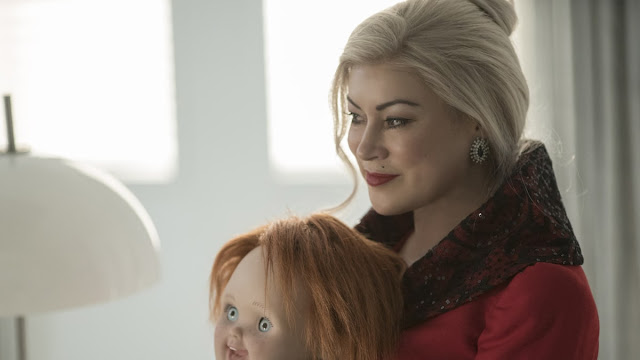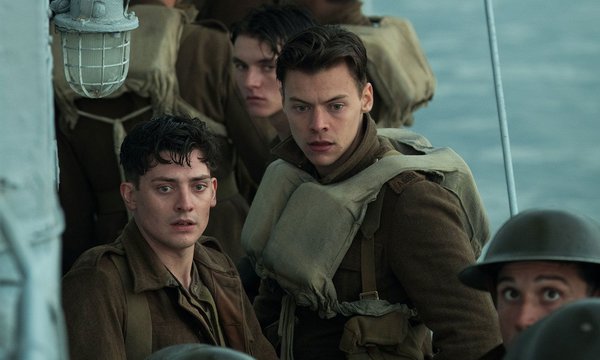"You have the right to remain dead.
Anything you say can and will be considered very strange…because you’re dead.
You have the right to an attorney, but it won’t do you any good because…you’re dead."
It’s only every so often that I
get to incorporate a youth-inspired memoirness to a write-up because there are only a small handful of films that, through
completely random happenstance, I saw at a very young age that catapulted me
into a permanent state of adoration for the genre. There's The Return of the Living Dead, the first Halloween and one of its sequels, Halloween 4: The Return of Michael Myers, and, hilariously, there's Tales from the Crypt Presents: Demon Knight. If your formative years are all encompassing, then I was all too eager to absorb every weird, scary, or gooey second from these movies and the horror genre at large.
For some reason, Psycho Cop Returns (aka Psycho Cop 2) is one of them.
Glimpsed late at night on the USA
Network’s B-movie showcase Up
All Night, hosted by Gilbert Gottfried and/or Rhonda Shear (I don't remember which one had this particular honor), and which also
presented such cinematic glories like A
Nymphoid Barbarian in Dinosaur Hell, Dr.
Alien, and Vampire on Bikini Beach,
my young eyes feasted upon a very censored tale of a
Satan-worshipping cop who zeroes in on a group of horny office workers hosting
an after-hours bachelor party for one of their own, who then secure a trio of
strippers and a filing cabinet of booze for a night of debauchery and having
asses danced right in their faces. Officer Joe Vickers, the titular psycho cop, finds his way into the building and begins dispatching
the office workers, the strippers, and whomever else might be around, all while
letting off a series of puns so unbelievably stupid that Freddy Krueger immediately pressed charges.
Even in my early teens I could see that Psycho Cop Returns was poorly made, in most cases poorly acted, and certainly poorly scored. (This is one of the worst musical scores – written by two people! – I’ve heard in a horror film other than Jason Goes to Hell, and that’s saying something, because Jason Goes to Hell features probably every example of “worst I’ve ever seen,” up to but not including usage of The Blues Brothers‘ Steven Williams.) Nothing about Psycho Cop Returns is surface-admirable, but I’ll be damned if it isn't fun. And if I said I wasn’t just the tiniest bit disturbed as a tyke during the opening sequence when the psychotic cop gets into his squad car to reveal a blood-splashed interior, dismembered body parts, and satanic symbols, I’d be fibbing.
For years following the immense
success of Die Hard’s debut in 1988, a slew of imitators came down the pike – some good, some not,
but all sold as “Die Hard on a
_____!”
Die Hard on a bus!
Die Hard on a naval warship!
Die Hard on the ice!
It became a tried and true method
for making your pitch as succinct as possible while also trying to suggest your
film would be at least as good as that Yuletide classic, and this lazy pitching gimmick reached across every genre aisle.
Psycho Cop Returns borrows that concept, presenting a sort of Die Hard meets Bachelor Party meets Friday the 13th: a group of office employees in a city high-rise are essentially taken hostage by a dangerous threat, who after neutralizing the only security guard, slips in unnoticed and attempts to blend in at one point to fool them. There are scenes in elevator shafts, on helicopter launch pads, a sexual tryst in an unused office. Only this time, it’s not the cop who will save the day. It’s the cop who will throw them off a building directly into a dumpster, then make a garbage joke while doing it.
And it’s tremendous.
 |
| John Wick was here. |
To those unfamiliar with the cinematic opus that is Psycho Cop Returns, the most surprising aspect would likely be the actor who takes on the murderous title role: stage name Bobby Ray Shafer, aka Robert Shafer, who might be most famously known as having played Bob Vance of Vance Refrigeration in several seasons of The Office. Schaffer, who has admitted as such since the movie's release, was hoping to parlay his predecessor, Psycho Cop, into a horror franchise all his own a la Nightmare on Elm Street – and the production house behind the first film was equally optimistic, signing Shafer to a staggering, pre-Marvel five-picture deal.
FIVE Psycho Cop movies.
Imagine living in a world so good and just where
that would've been allowed to happen.
Sadly, Psycho Cop Returns would be the second and final in the series (so
far – I would totally see Old Psycho Cop tearing ass around wherever
old people hang out and do illegal things). By all accounts far better than its
predecessor, Psycho Cop Returns is
100% video store shelf sleaze. Not nearly soft-core porn, but pretty close,
there’s a detectably slimy and greasy vibe covering every frame that adds to
the film’s appeal. Also appealing, and I’m being 100% serious: the screenplay.
Yes, the story is very derivative of the aforementioned Die Hard and the dozens of slasher flicks that came before it, but the
screenplay by Dan Povenmire, who worked as an animator for The Simpsons, is actually well written. Not the action, mind you,
but the dialogue between characters. Jokes (non-murderous ones, anyway) feel
natural. The ribbing between coworkers feels genuine. The exchanges really do
bring at least an attempt at everyday life, even if the characters are nothing
more than half-formed archetypes: the horny guy, the nervous guy, etc. And the
ending, which both spoofs and embodies the grainy Rodney King beating
footage, which was a huge cultural event in 1992, it suggests
that, maybe — just maybe — Psycho Cop
Returns had something to say all along.
Of all the stupid undeserving
horror franchises that don’t realize they’re stupid (Saw, The Purge, and so forth),
it really is a shame Psycho Cop
didn’t spawn more than one sequel, because at least it knew what it was, and
wasn’t vying for anything more. Its only immediate competition was the more
restrained, the more hyperbolic, and the more Bobby Davi-having Maniac Cop series, which petered out
with its lame third entry, but it’s typically the franchises that tend to strive for
higher quality and relevance that run the risk of diminishing returns. Psycho Cop wasn't worried about that. Psycho Cop wanted to have sex, kill
people, and pun. It’s not exactly a difficult beat to walk, so it’s a shame this cop retired so early – he definitely wasn’t too old for this shit.
If you have only a passing, casual interest in the horror genre, then holy shit, just keep walking, because this will not be the film that converts you. Psycho Cop Returns is 100% for people who live, breathe, and bleed the genre. Every single person involved in its making knows that it’s stupid. Not a single person among them has any delusions that maybe Psycho Cop Returns is a slice of cinematic genius capering as something less. No. Psycho Cop Returns features a scene in which Officer Joe Vickers stabs someone in the eye with a pencil and then makes ten “eye” jokes about it. And that’s totally fine with me.



























